When the first few rain drops of the monsoon season touch the water-parched land, it almost instantly transforms it into something magical. As clichéd as it may sound but rains do have a ‘magical’ effect on places as much as they do on people as they offer a pristine experience, and the best of it all, of a place.
Monsoons in India are very special as after the unbearable, scorching tropical summer season, the land as much as its people are only thirsty for water. So, as soon as the monsoon winds make their first landfall, in the south-western end of the country, the rest of the country is already breathing a sigh of relief.
When the monsoon rains bring down land temperatures, they basically are cooling off people too and serve as an automatic call for a time out, a break – from the rigmaroles of life and the dreariness of things in general.
Monsoon typically starts in the first week of June in Kerala, then travels up towards the land mass of the country and continues to move till about September. The best way to enjoy monsoon is to travel to destinations that offer nothing less than a once-in-a-lifetime memorable experience.
Nature in abundance
Monsoon is one of the best times of the year to experience the beauty of nature. The magical monsoon touch makes everything beautiful and green. The trees become greener than green, the sparkling water becomes bluer and brighter, the hills and mountains don an endless green cover and almost every corner of earth seems to be taken over by nature.
Meghalaya’s Shillong also known as the ‘Scotland of the East’ is considered to be one of the best destinations for travel during monsoon. During the monsoon season, misty clouds seem to envelope the town. The best things to do here include taking road trips around the hills, enjoying panoramic views of the lush green mountains engulfed in clouds, enjoying the many waterfalls in the area and sipping on hot tea and snacks in cozy hotels.
Ranikhet located in Almora district in Uttarakhand is also one of the favourite tourist destinations during the rainy season. The zone offers a scintillating view of the Himalayas as the town is located at a height of 6,000 feet above sea level amid the gorgeous Kumaon hills. Travelers can experience the beautiful Rani Jheel or the many fruit orchards including that of apples, peaches, apricots, etc.
Another destination that is extremely popular among tourists during the monsoon is Darjeeling. One can never get bored of the charm of this hill station. The Queen of Hills, as it’s popularly known, located at the foothills of the Himalayas, attracts tourists to its tea plantations, lush green hills and the toy train ride. The nearest rail station is New Jalpaiguri that connects Darjeeling to major cities of India such as Kolkata, Guwahati, Bhubaneswar, Delhi, Mumbai, Chennai and Cochin.
A very romantic destination, more so during the rains, is Coorg in Karnataka. The dense forests in the zone are home to a variety of flora and fauna. Coorg is also rich in huge coffee plantations, scenic waterfalls and breath-taking views of the hills that add a romantic charm to the place. The town is also popular among trekkers and bird watchers who come in huge numbers during the rainy season.
Experiencing wildlife
Every element of nature, including birds and animals, the wildlife, are teeming with life when monsoon arrives. There are several travel destinations in India that offer the best of wildlife experiences during the monsoons.
The Okhla Bird Sanctuary, situated within the short distance of 15 kilometres from Delhi, is a place that transforms during the rainy season. A bird sanctuary at the Okhla barrage over Yamuna River, it is roughly four square kilometres in size and is situated at the entrance of Noida in Gautam Budh Naga district of Uttar Pradesh. The Sultanpur Bird Sanctuary is the most unusual place where you would get a memorable bird-watching experience. One of Gurugram’s (Haryana) most popular tourist spots, the place welcomes several species of birds. The birds here can be easily spotted wading, swimming or flying. Every year, 90 migratory bird species arrive in search of feeding grounds and to spend the winter.
The Periyar National Park is a protected area, an elephant reserve and a tiger reserve, located in the districts of Idukki and Pathanamthitta in Kerala. The park is home to rare, endemic and endangered flora and fauna and forms the major watershed of two important rivers of Kerala, the Periyar and the
Pamba.
One of India’s most prominent and popular wildlife sanctuaries, the Ranthambore National Park, a wildlife reserve near the town of Sawai Madhopur in Rajasthan, is also a must-visit destination during monsoons. Spread over 1,334 sq km, the reserve is known for its population of tigers and the magnificent forts in the vicinity. Maharashtra’s Tadoba National Park is also one of the best tiger-spotting regions in India. The reserve is known for frequent spotting of tigers, panthers, hyenas, sambars, etc.
 Misty clouds over Araku Valley
Misty clouds over Araku Valley
The wildlife sanctuaries in Goa are some of the best places to visit during monsoon. Unlike most other similar places, the reserves in Goa are open throughout the year. It’s imperative to experience one during the rains. The wildlife sanctuaries in Goa are Mhadei Wildlife Sanctuary, Bhagwan Mahavir Sanctuary, Mollem National Park and Bondla Wildlife Sanctuary.
Keeping home safe during travel
During any kind of travel, it’s important to keep oneself safe and secure. Similarly, when embarking upon any trip during the monsoon, it’s equally important to ensure that the house that you are leaving behind is in good shape and safe from the rains. While the rains wreak havoc on the roads and infrastructure in cities like Mumbai, the walls of your homes aren’t safe either. They take the worst bashing even while you stay safe.
Buildings suffer from leakages for a host of reasons with faulty construction, sub-standard materials and age being among the regular culprits. Some causes such as leaking drains and faulty water supply pipes located on the exterior walls of the building need to be repaired in time to prevent seepage.
You know that the exterior walls of your society need to be waterproofed when during the monsoons, cracks and wet stains appear on the interior walls of your home.
If it’s the rains that are causing the problem, the only solution one can avail is timely waterproofing of exterior walls that can only be done before the following year’s monsoon. Waterproofing should be carried out on the exterior walls plus common and private terraces.
However, if your building has recently been waterproofed and you notice wet stains on the wall beneath your window, it could well be due to improperly sealed windows where the frame of the window has deteriorated and is allowing the rainwater to seep into the walls. To fix this, you will need to have a mason reinstall the window frame correctly or install a new window frame.
Salvaging one’s home, its walls and exteriors from the rains is an equally-important task to make sure your trip is enjoyable and stress-free and you return to a dry, clean home.


 Meghalaya in the North East is one of the best destinations to travel during monsoon
Meghalaya in the North East is one of the best destinations to travel during monsoon